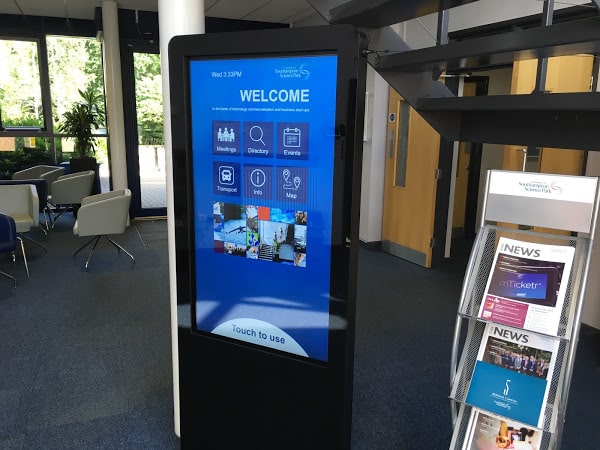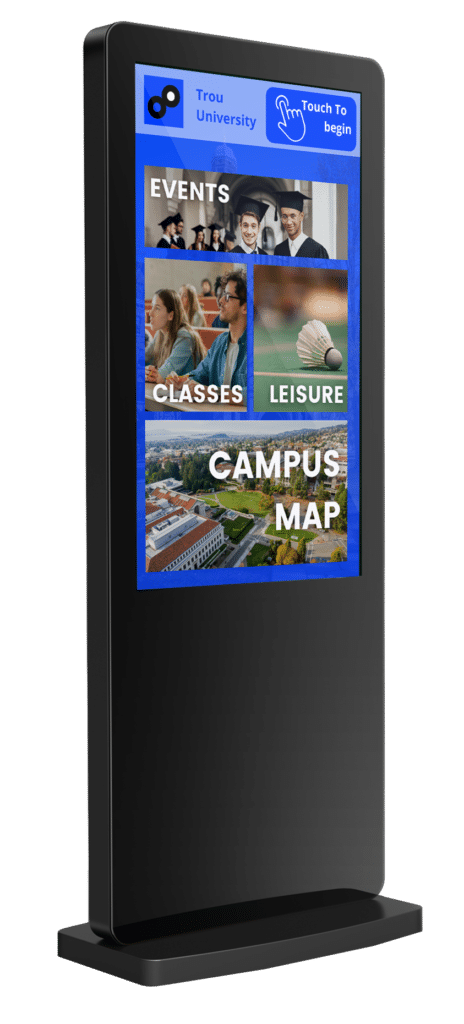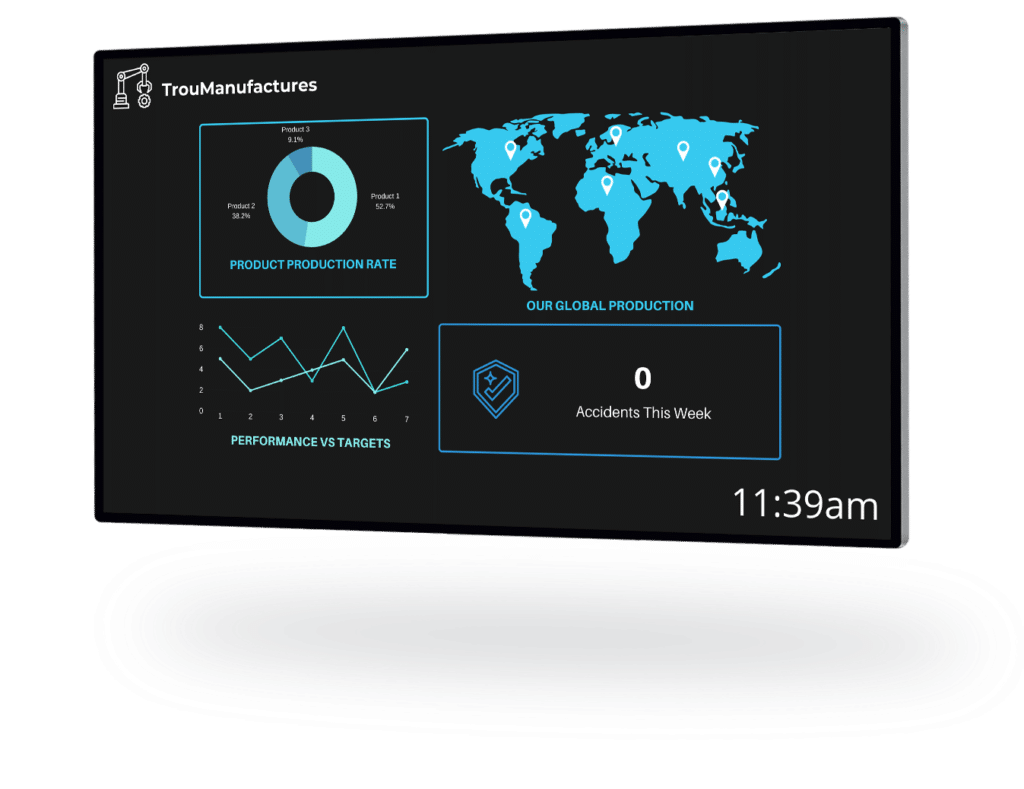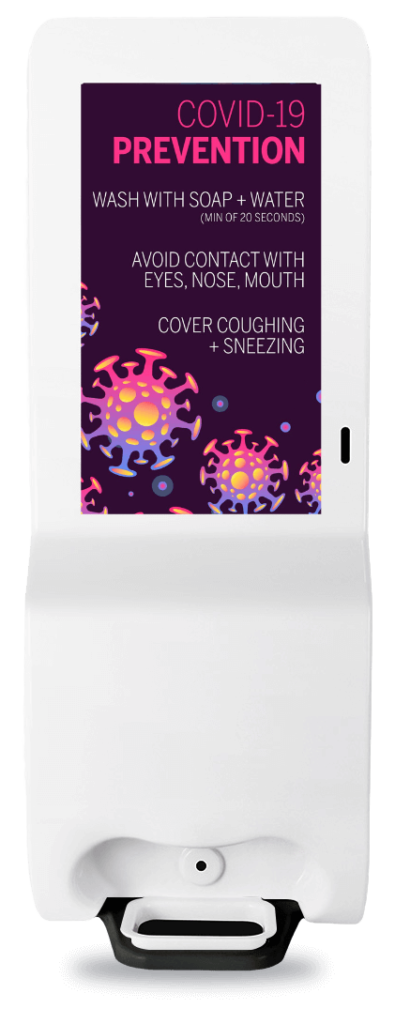As life returns to normal, university and college campuses will once again be full of activity. With a rush of people coming and going every day, campuses need efficiency. On top of this, young people are more technologically savvy than ever, expecting an intuitive and digitally advanced experience. As a result, becoming a smart campus is now the way forward.
In 2019, Gartner identified smart campuses as one of the top ten strategic technologies impacting high education, and this continues into 2021. A smart campus uses advanced network infrastructure and internet-connected devices. The Internet of Things (IoT) remotely connects, senses, and controls these various devices. At the centre of any smart campus is a web of digital signage solutions and screens, indoors and outdoors.
This blog offers our top 5 smart campus technology examples for 2021. With these digital screens and solutions, campuses can streamline their operations, improve communication, reduce human resources, and increase stakeholder happiness.
1. Digital Posters For A Smart Campus
University campuses always have something going on, from general lectures and seminars to open days and events. Deploying posters and banners across campus can be time-consuming and impractical, let alone bad for the environment. Print media is also time-sensitive and space-restrictive and cannot be updated immediately. Save time, money, and the planet by resourcing digital posters.
Digital screens displaying digital posters are a great benefit of smart campuses. These screens can be located throughout campus in prime or high human traffic areas, such as on a busy path, outside a large lecture theatre, or in a student pub.
This smart campus technology can promote events, lectures, or even a student union candidate. They could also display promotional offers for the student union, pub, or café. Due to being digital, content can be updated immediately, such as if there is a venue or time change. Moreover, smart campus IoT can trigger on-screen content promptly, such as in emergencies. This ability cancels out the need to print more posters or update by hand every print poster plastered around campus.
In addition, there is only so much physical space print posters can take up before a wall becomes a sore sight or the signage gets lost amongst the rest. With digital signage, content can be rotated in a playlist, displaying all events, promotions, or features in one place with equal air time.
The screen quality of digital signage hardware will also ensure that text is readable and images are sharp, increasing potential views and engagement. Moreover, this smart campus system gives people the opportunity to bring their posters alive with multimedia content, such as video clips, to grab more attention.

2. Digital Information Hubs And Kiosks
University campuses are host to a wealth of information, not just in the minds of its academics but in the site itself. Visitors often require information about parking, conference rooms, dates of events, bus times, or space available in the library, to name just a few needs. With digital information hubs and digital kiosks across campus, display information to answer all the necessary questions visitors might have.
The benefits of these smart campus systems are staggering. Firstly, when changes occur, information can be immediately updated through digital signage software or connected via smart campus IoT, saving time and money. And, secondly, with the scheduling functionality of digital signage software, content can be prepared in advance, ready to broadcast when necessary. This preparation avoids delays in getting messages out or operations on the day.
Digital information hubs and kiosks can be traditional or touchscreen (or even touchless with voice or gesture sensors). These options allow people to find information using a method that suits them and reduces the need for human resources. This benefit maximises the chance of people discovering necessary information in one place, rather than being transferred to a chain of staff. This smart campus example provides people with information efficiently, perfect in our fast-moving society, increasing stakeholder satisfaction. In fact, a recent survey from TrouDigital found that 95% of students and recent graduates believe “digital displays are beneficial for student communication”.
One example of a digital information hub/kiosk is at the campus bus stop/station. At a smart campus using IoT, utilise a digital screen to display live bus times and even current locations. Further information could include bus timetables or rules. This accurate data will improve customer satisfaction by giving a real-time answer rather than expectation.

3. Digital Wayfinding Round A Smart Campus
Digital wayfinding has risen in popularity across a range of sectors with great benefits. These touchscreen kiosks or screens aid users in their navigation of the campus, presenting an in-depth map.
Digital wayfinding solutions are a critical piece of smart campus technology. They extend beyond the classic yet often too simple “you are here” pinpoint, and map out a tailored route from the current location to the desired destination. This functionality also offers virtual walkthroughs.
This smart campus system improves the stakeholder experience, presenting a quick and easy-to-follow direction solution. Moreover, wayfinding software can enhance user experience with personalised messages; if a popular conference is happening, digital screens can have directions or welcome messages scheduled.
Critically, through installing IoT sensors on existing infrastructure, problems with routes, such as uneven pavement, construction work, or a fire, can be identified and fixed or can feed into digital wayfinding technology to signal the need to provide an alternative route. This ability is particularly crucial for increasing campus inclusivity. Sensors can assess and feed information to smart campus systems regarding when lifts are unavailable, when pathways become non-wheelchair accessible, or when an areas footfall becomes busy. This need for up-to-date information makes digital signage and smart campus technology an unparalleled and necessary source of communication.

4. Digital Dashboards
Understanding data is key to a thriving higher education institution. Digital dashboards can, therefore, bring many positives to a campus. On the surface, digital dashboards can increase institution transparency, for example, presenting results on student satisfaction to the students themselves. These dashboards can connect to interactive digital screens with touchscreen polls that feed the results into graphs and tables.
Alternatively, use the digital dashboard widget to present live fundraising totals of student societies. This feature can encourage competition amongst students and simultaneously raise more money for charity. Or, at a smart campus using IoT, digital dashboards outside the library could provide live information on how many seats are available, when the peak hours are, and floor density maps. On the same screen, a banner could remind people to return their books, highlighting a clear benefit of digital signage; it allows multiple messages to be displayed on-screen at one time.
On a staff level, this smart campus example can keep institutions running efficiently. In department offices or staff rooms, digital screens can provide live data on student results or attendance, or in finance, screens can show live outgoings and income. By implementing digital dashboards across departments, all staff can keep track of their performance and work towards the department or institution common goal.

5. Digital Hand Sanitisers
Digital hand sanitisers were a hot trend of 2020. As vaccine numbers increase and normality is on the horizon, the need for digital hand sanitisers may seem far-fetched. Nevertheless, following the pandemic, people are expected to maintain a focus on hygiene. As a result, digital hand sanitisers are a great solution to this persisting need for cleanliness.
Digital hand sanitisers are beneficial to the smart campus system because they provide hand sanitiser and important messages to users. These can include hygiene and coronavirus messages, promotions of campus food and drinks venues, or library reminders. The possibilities are near limitless.
Additionally, you can use this smart campus example to track how many people are still hand sanitising to inform whole campus decisions on hygiene and social distancing, if necessary. A smart campus using IoT can also work out what areas need more cleaning, where the most footfall is on campus, or where to target messages more.

Young people thrive on rapid communication and innovation. The future of higher education needs digital signage to keep up with the pressures of the modern world. As technology becomes cheaper and readily available, almost any campus could become a smart campus.
If you have any questions related to smart campus digital signage, speak to an expert today. Call our friendly team on 02380 981110 or Email info@troudigital.com for a no-obligation consultation. Alternatively, click the button below.
